The “Secret” to Successful Mahi Fishing Trips in the Florida Keys
Whether you call them Mahi-Mahi, Dolphinfish, Dorado, Coryphaena hippurus, “Maui,” or any of the other dozens of names we have heard this fish called, most agree that Mahi are an extraordinary fish.
The voracious appetite of Dolphinfish combined with their ability to reach sexual maturity within 2-3 months allows them to reproduce at incredible rates. Mahi are the fastest-growing fish in the sea, capable of growing more than 2.5 inches per week, reaching lengths of 4 feet, and weighing up to 40lbs within the first year of life!
Dolphinfish are also a blast to catch, offering fun and acrobatic fights to anglers. Customers are always amazed by their beautiful bright colors from green to yellow, blue, and even white. On top of all that, Mahi is delicious low-calorie food that is high in protein, vitamins, and minerals. The Dolphinfish is, in many ways, the perfect fish and, in our opinion, a gift to the human race.
We could go on for quite some time about all the interesting facts about Mahi, but that is not what this article will be focusing on. If you are looking for a short overview of Mahi fishing in the Keys, you might want to see this article.
Still here? Ok great! The purpose of this article is to discuss in-depth the various factors that will play a significant role in the success of your Mahi fishing trip in the Florida Keys. If you are headed to the Keys and plan to fish for Mahi, this article should help and give you insight into what you can expect, especially if you have booked a fishing trip with the Main Attraction.

First Mate Lance bailing schoolie Dolphinfish aboard the Main One.
Fish Size
In general, we describe Mahi in different terms that represent their sizes. These sizes are subject to interpretation from one Captain to the next. First, we will define these terms as we plan to use them throughout this article.
Peanuts and Lifters
Peanuts are small Mahi that are illegal to harvest and are released immediately as per regulations. However, it is worth it for a Captain to take a moment to look around in this scenario, as enormous predators such as Marlin, Huge Sharks, Wahoo, and Slammer-sized Dolphinfish love to eat peanut-sized Mahi!
Lifters are small, yet, legal to harvest Mahi that are at least 20 inches to the fork or a little larger. These fish are lifted into the boat using the leader since they only weigh a few pounds.
If the fish are on the smaller side but legal to keep, your Captain will likely recommend harvesting some, so you have food before moving on to look for some bigger Mahi. As the customer, you have the final say as they are your fish, and we encourage you to express your intentions with the fish you catch. Your Captain will be happy to recommend whether or not you should keep a fish depending on your goals, how many fish harvested, and the time left on your trip.
Schoolies and Heavy Lifters
These 3-8lb Mahi are our summertime bread and butter. They are the perfect eating size and quite delicious when eaten fresh. If they are frozen soon after being caught, they will hold up in the freezer well and taste great when you are ready to use them.
Gaffers
These are Mahi that are too large to lift out of the water using the leader, and must be gaffed, usually 10lbs or more. When you find a large school of 20-30 hungry Gaffers, you can make your whole trip right there, and it’s a lot of fun. Gaffer-sized Mahi are a delightful balance of tasty to eat but also challenging to catch on light tackle.
Slammers
This subject is hotly debated; for some, it’s 20lbs and above, others say 30lbs, and the saltiest of Captains claim it is 40lbs and up. We leave this up to the Captain to decide, but we all can agree these large fish are exceptional. Slammers help us win tournaments, and they add a ton of excitement to a fishing trip, making it truly unforgettable. Usually, we find them in a male and female pair that we call a Bull and Cow, but sometimes we get a small group of 3-5 huge Mahi which can be pandemonium on the deck when that happens. Very exciting stuff!
Super Slammers
Not sure if “Super Slammer” is an official term, but basically, a Mahi over 50lbs would fall into this category, which we do catch from time to time. These are rare catches, and when it happens, it is usually a Bull accompanied by a Cow in the 30-40lbs+ range. We often end up catching the pair, which is a huge bonus. The level of adrenaline rush everyone experiences when a 50lb Mahi appears is hard to describe unless you experience it firsthand.
Opinions On Size
Sometimes we receive negative comments on social media for keeping a Mahi that someone thinks is too small to harvest, or conversely, they feel it was so large that it should have been released. While everyone has a right to their own opinion, we maintain a straightforward and clear stance on this.
When you catch a fish on our boat, we measure that fish, and if the fish is legal to harvest, you as the paying customer may keep that fish. If you wish to release your fish instead, we are equally happy to do so. Any fish caught that is illegal to harvest will be released immediately from our boats.
Once we get your fish back to the dock, your Captain will fillet your fish until they fill up a 5-gallon bucket worth of fillets: about 50lbs of boneless meat. You may take any remaining fish as well to clean on your own.
At the end of each fishing day, all catches, whether harvested or released, are logged by each Captain and reported to Main Attraction co-owner Katie Lewis. At the end of each week, Katie reports these records to the National Oceanic and Atmospheric Administration.
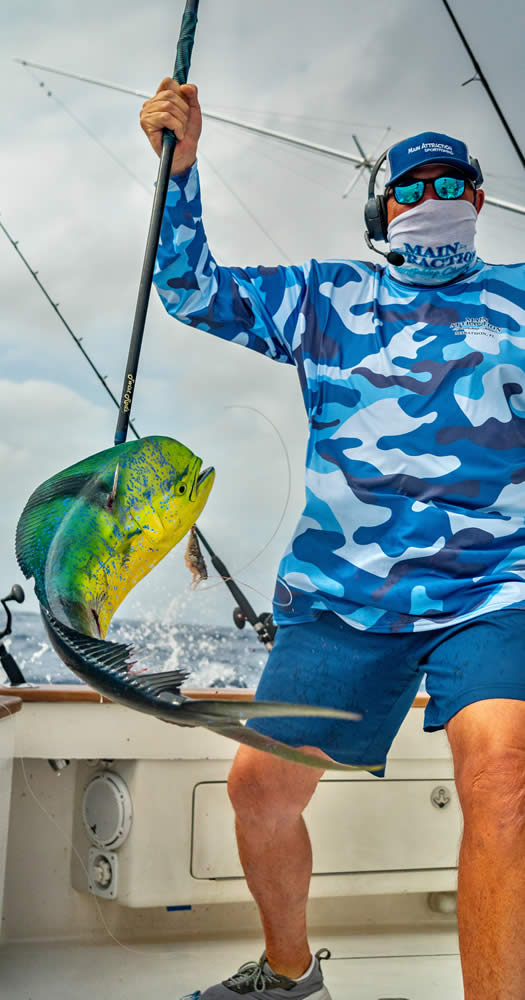
Mahi come in all shapes , sizes, and colors and they are all beautiful!
Keeping An Eye Out
Having a good pair of well-trained eyes can be extremely helpful when Mahi fishing. Captain’s have an advantage from their tower when it comes to spotting floaters and fish in the water, but Mates have an essential role to play as well.
Being on the deck gives Mates the ability to spot a set of birds against the backdrop of the sky on the horizon. This is why we train our Mates to keep their heads on a swivel and constantly be on the lookout for birds while they perform their tasks.
We also encourage our customers to keep an eye out and report anything they see that might indicate fish.
Not only does this keep the customers more involved and make the trip more fun, but looking for birds on the horizon is a great way to keep them from getting seasick!
For The Birds
It is crucial to realize that not all sets of birds are worth heading to, so if you spot a set, do not take it personally if your Captain doesn’t run toward them! Our crew members can look at a set of birds and often determine what fish they are following depending on the type of birds, their behavior in-flight, and the amount of them.
For instance, a large set of small birds moving at high speed on the open water is usually on a large school of Skipjack Tuna or Bonita. Trying to get baits in front of a very fast-moving set like this can often feel like chasing your tail. Additionally, our clients would prefer to eat sushi-grade Blackfin Tuna and Mahi. For these reasons, these sets are generally not worth our time.
A smaller set of medium-sized birds around a large structure underwater, such as the Hump, will not be moving as quickly and will often be Blackfin Tuna, which is definitely worth our time.
A Smaller set of birds around a weed line or floater is typically going to be Mahi. A small group of large Frigate birds (1-3) often indicates a small set of big Mahi (gaffer to slammer sized).
Spotting these sets of birds from miles away and knowing whether or not it’s worth chasing them down, burning the fuel, and bringing the boat in that direction is one of those skills a Florida Keys Captain develops with experience. If you are fishing with Main Attraction, rest assured your Captain has done this many times!
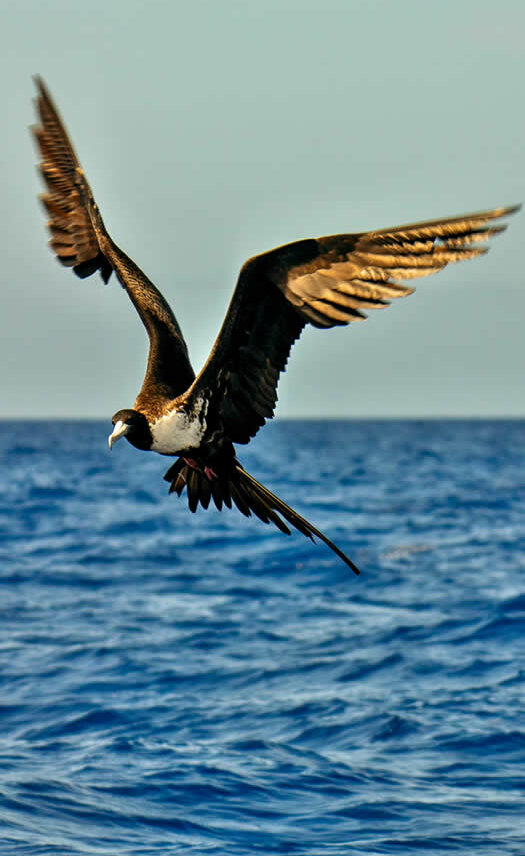
The Frigate bird is revered by our crews. They help us find the big Mahi!
Floaters
A floater could be anything floating in the ocean. Our Captains and Mates see all sorts of stuff floating offshore since they fish daily. Many of these floating objects attract smaller fish that try to hide under them for protection from predators. While these can serve as protection from threats above and below, they also attract predators for the very same reason!
The more aquatic growth and vegetation on a floater, the longer it’s been in the water, and a more established floater is usually a better chance of catching something off of it. A wooden palette or a big tree makes for a great floater to find Mahi underneath. We also find abandoned homemade boats and rafts that migrants from Cuba use to get to the states. While an abandoned makeshift vessel can give you an eerie feeling way offshore, almost all of them are spray painted with the words OK on them to let aircraft know the US Coast Guard has already rescued the boats passengers. These floaters often have fish swimming under and around them. A buoy or other floaters with a long rope attached can also have a Wahoo hiding 50-100 feet down that can be raised with a Jig or trolling nearby with a planer board.

Abandoned Cuban rafts often have bait fish and predators swimming nearby.
Certain floaters aren’t good at holding fish, and a Captain must be careful not to lose precious time and fuel heading in the wrong direction after them. For example, millions of Mylar Balloons are released from land every year, and sadly, so many of them end up in the ocean and kill countless animals. We can spot the glint of the sun off a mylar balloon on the ocean from many miles away in our towers or the white of a bleach bottle from far away. These are not good floaters, and as a Captain, if that balloon is taking you in the wrong direction, you need to recognize that as early as possible and change course!
It is also essential to recognize you are not the only boat on the water. Sometimes you get to a floater that looks like it should have a ton of fish on it, and it doesn’t. If this happens, do not be discouraged. It probably had fish, and it’s been cleaned out by other boats. Time to look for another!
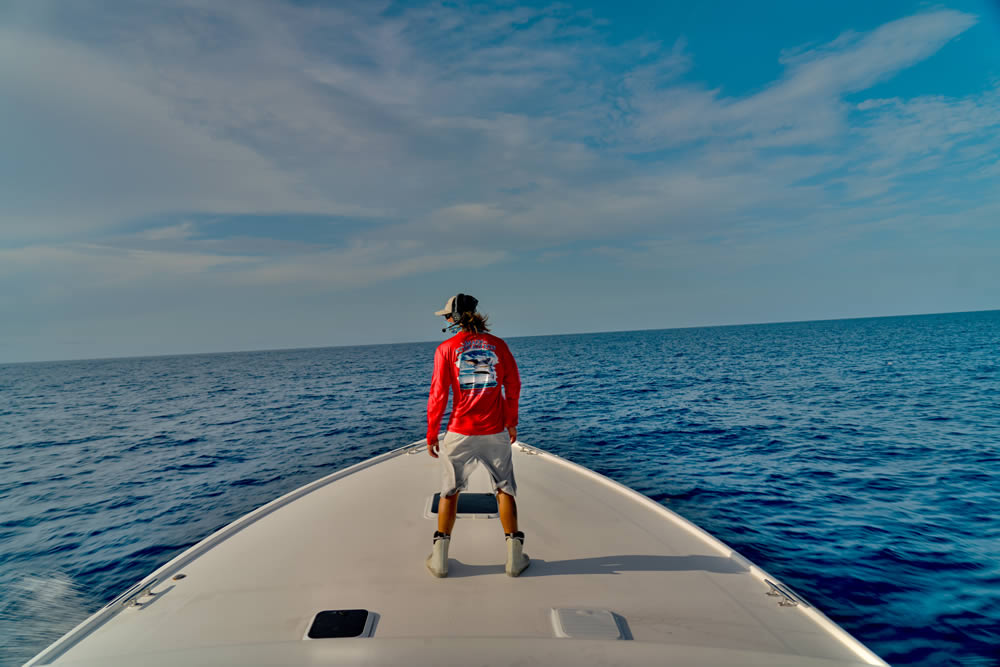
We train our Mates to constantly be on the lookout for floaters or birds on the horizon.
Weed Lines
Sargassum Grass can form weed lines and patches depending on the current. We typically look for lines traveling east to west in line with the way the fish are traveling.
Weed lines that also have a set of birds working them are an excellent sign of Mahi. Flat calm days with no current and vast patches of grass without birds or other signs of life often yield no results.
Captains must use their judgment on whether to inspect scenarios like this but trolling by to check if you are unsure is never a bad idea as it doesn’t take long. If you see your Captain putting out lines trolling a weed-line and quickly after pulling the lines back in to move elsewhere, don’t be discouraged! He’s not taking you for a boat ride. He is fishing proactively and doesn’t want to waste his time when he knows there aren’t fish in that area.

Weed patches without birds may not have Mahi under them, but tossing in a few lures and trolling by to check doesn’t hurt.
Sometimes the current or wind isn’t cooperating, and there are scattered weeds everywhere, which can make trolling a pain as the hooks keep getting snagged on grass.
If the visibility is decent, your Captain Might switch to a purely run and gun style of sight fishing using the tower to see fish in the water and having the Mate cast directly at individual fish instead of trolling. This style of fishing is very exciting when there are fish around. On slower days this style of fishing might again make you feel like you are on a boat ride. While you might feel like you are doing more searching than fishing on these days, this is how we must fish in the Keys when the conditions call for it.
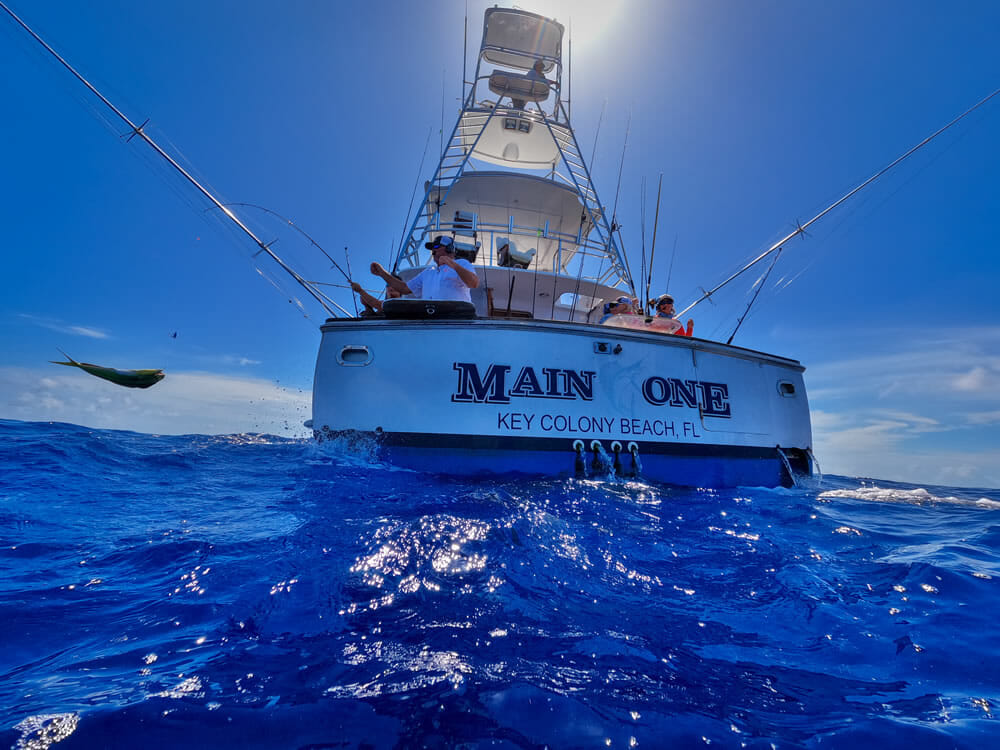
Captain Marty Lewis and Mate Lance Doire helping their customers catch a school of Dolphinfish.
Artificial Lures
Every crew member has their preferences, but our general rule of thumb for lures is to use brighter colors on sunny days and darker colors on cloudier days.
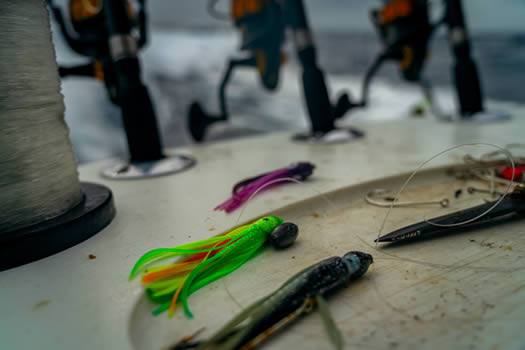
We tend to use darker colors for Tuna and brighter colors for Mahi.
This approach might seem counterintuitive, but the color doesn’t matter nearly as much as the silhouette of the bait as it moves through the water. If your lure color contrasts nicely with its backdrop, it will be more visible to the fish. We tend to lean towards darker colors for Tuna and brighter colors for Mahi.
Not surprisingly, we also find that Mahi fishing is usually better on sunny days, and Tuna fishing is generally better on cloudier days.
Perhaps this is because the Tuna’s large eyes are sensitive to the brighter days, keeping them down deeper. Maybe it’s because Tuna have great vision and can see the leader much better on a sunny day.
Either way, we find for Tuna, that a nearly invisible lighter fluorocarbon leader paired with red and black lures or purple and black lures are very effective on the troll versus the heavier Mono leader and bright colors we use for Mahi lures.
Natural Lures
We also rig dead Ballyhoo and brine them the night before to use when trolling like a naturally scented, swimming lure.

Captain Marty’s son Alex Lewis rigs a naked ballyhoo for trolling.
When we fillet our customers fish we save the carcasses to make bait from for the next day. Strips of belly meat from Mahi, Bonita, and other fish can be pulled while trolling effectively. Our Mates pull these natural lures either naked or skirted, depending on the conditions of the day, speed the Captain is trolling, and what seems to be triggering the most bites.
Bait
Once a school of Mahi is behind the boat and settled in to feed, our crews present the fish with various baits to hook each fish one by one until, hopefully, the entire school is in the fish box.
On many days when a school of Mahi fired up behind the boat, they will pretty much eat anything, but they are not like that every day. Some days they will only eat squid or cut up fish or shrimp, or lures. It’s bizarre, but it’s true. On a few days here and there, the Mahi we find won’t eat any dead baits offered at all! In this scenario, we offer live bait and hope it triggers bites as that is pretty much the only remaining option.
Oddly enough, this feeding behavior seems to predicate from one school to the next on any given day as if they all decided together they would be picky or hungry on that particular day! These observations prove that certain factors such as weather and other conditions directly impact how Dolphinfish feed and behave in general.
This is one of our “Secrets” to successful Mahi Fishing; being prepared with various baits to present to Mahi if they are picky that day. Do not commit to one bait, be creative!
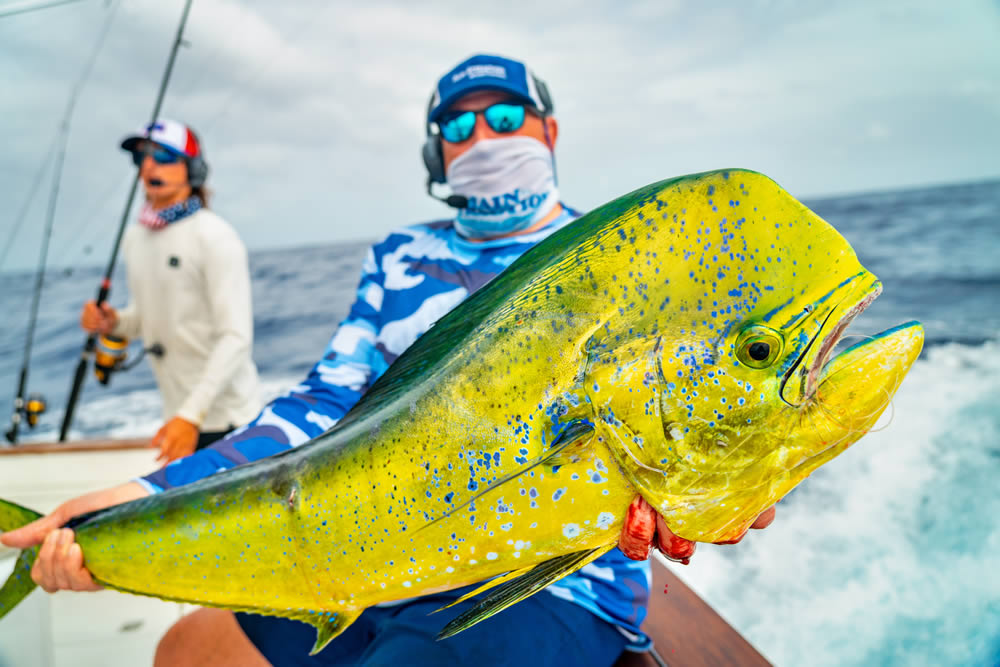
Frequent Main Attraction client Mark Busch holding up a Dolphinfish.
Putting Out The Spread
Once we have our lures and baits prepped and are in an area that looks fishy, it is time to put out our spread. A basic Mahi Spread is all you need, nothing fancy. The key is to have a spread that can hook one or two fish to bring the entire school following right behind the boat. A simpler spread can be cleared faster to quickly cast the cut baits into the school to hook more fish.
Depending on the size of your vessel and how windy it is, 2-4 lines are all you need in your spread. Pulling a huge spread of lines and teasers can cause tangles and complications that slow down your ability to pick up your lines and move to a new area. At least one of your lines should have naked or skirted Ballyhoo on it. You may see our Mates putting the ballyhoo bait in a rigger so they can let it float or slowly sink when the boat stops trolling as they reel in the artificial lures first. Why? Because we might get a bite from a Mahi swimming by while we are clearing the other lines. They might eat a lure as we are winding it in, or they might eat the Ballyhoo as it’s floating away. Little tricks like this allow us to be fishing while the boat is stopped, and this knowledge comes with experience.
Most of our tricks are related in some way to efficiency. Inexperienced mates might have the look of a chicken running around with no head in a high-pressure situation. They might move fast, but they also waste time as they move inefficiently. Experienced mates move gracefully throughout the cockpit without wasting movements and have excellent situational awareness.
The Captain speaks to their Mates simply with the throttles of his vessel. Notice when you come Mahi fishing with us how the boat might speed up all of a sudden and the Mates already reaching in the live-well for a live pitch bait because the change in speed alone told him the Captain sees a set of fish! When it comes to Mahi fishing, speed and efficiency that comes with practice are very important and also one of the “Secrets” to having a great Mahi fishing trip.
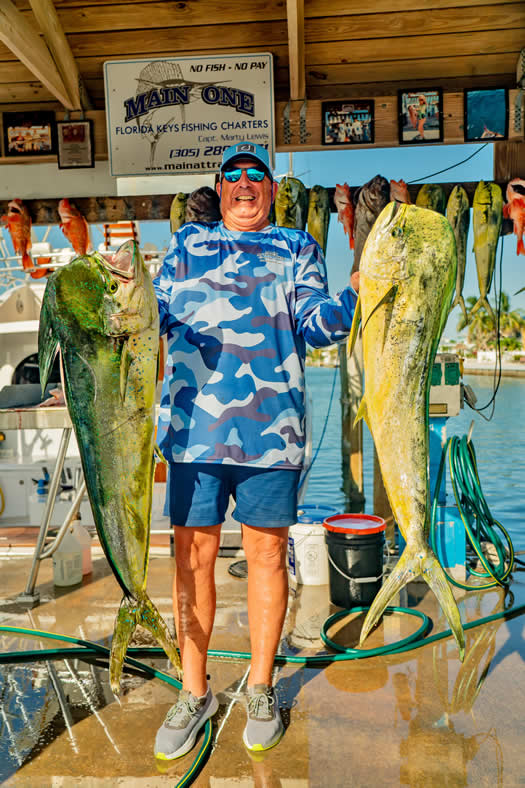
Repeat Client Mark showing off his catch for the day!
Hooked Up
When it comes to targeting Dolphinfish, our crews’ goal is simple; they want to hook a Mahi that will hopefully bring an entire school following behind the boat for the anglers to catch one by one. As the customer is reeling in the first fish, the Mate is casting cut bait behind the boat to the other Mahi that are following the hooked fish.
Some Mates instruct you how to hook a Mahi using this very first example; others will do it later after the fish are settled in. Either way, observe closely how the Mate hooks the fish. The Mate will cast the cut bait behind the boat to the school and leave the spool open. Once the fish eats the bait and line starts peeling off the spool, they point the rod at the fish, close the bail, and wind quickly until the fish is hooked.
When the customer gets the first Mahi to the back of the boat (assuming it is average size), the Mate will leave the fish in the water and put the rod in a holder.
The Mate will leave just enough line that the fish can circle and swim without being pulled out of the water by the rise and fall of the boat. However, the Mate can not set the line too long either, as this would allow the fish to tangle with other lines. At this point, hopefully, an entire school of Mahi has settled in behind the boat, and the clients are happily all fighting fish.
As a customer, feel free to be involved and grab a rod and drop a bait back to a Mahi yourself. Just be sure to listen to your crew’s instructions and try not to cause tangles!
It is not unusual for several rods in rod holders with caught fish circling when this is going on. This is when the Mate will start harvesting (or bailing) the fish to clear hooks for reuse on the remaining school. In this scenario, it is easy for anglers to cross lines and get tangled, so everyone needs to listen to the Captain, who will be hollering instructions such as who needs to switch positions to uncross lines. This “dance” can seem crazy and chaotic at times, but it is also addictively fun and requires a lot of coordination and communication to accomplish. For these reasons, teamwork and effective communication are one of our “secrets” to a successful Mahi fishing trip!
Preparation Is Key
From the point you book your trip to the time you show up at the dock to fish, there is lots of preparation for your trip that you do not get to see. Our crew members’ daily tasks include cleaning, refueling, and maintaining their vessels. They must also clean and maintain their fishing gear and prepare lures and dead baits for the next day.
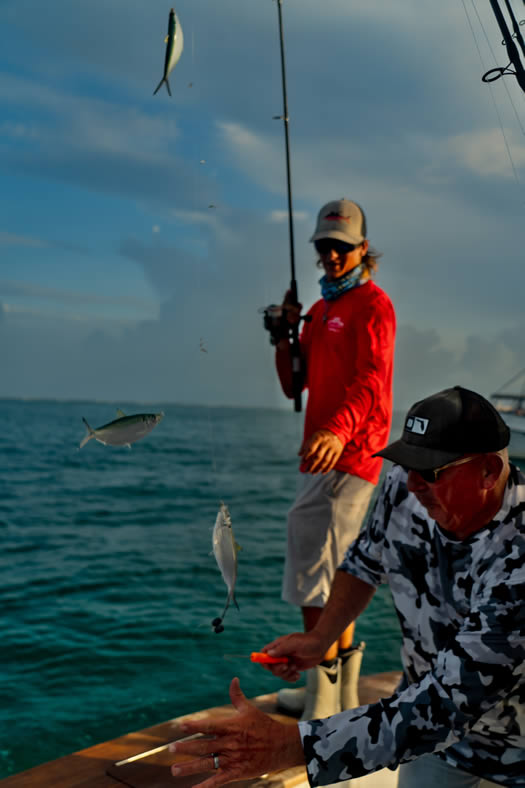
Mate Lance Doire hooking Pilchards on a sabiki rig on the reef as client Mark Busch dehooks them.
Our crew members work tirelessly year-round to ensure live bait is waiting on your vessels when you show up as often as possible. Our crew members primarily catch Pilchards for live bait in the wintertime, throwing cast nets early in the morning just as the sun rises and ferrying the bait in tanks to our vessels and bait cages before their trips. In the summertime, however, live bait needs to be acquired by other means. Our crew members accomplish this by using fish traps and catching pilchards inshore by sabiki in the afternoons. Sometimes they must catch Pilchards on the reef using sabikis or throwing cast-nets on Ballyhoo on the reef before heading out. Live Ballyhoo does not survive in bait cages; they need to be caught the day of your trip if required.
Our customers appreciate that we go to such extensive lengths to minimize bait catching on their fishing time. That being said, from time to time, given the circumstance, we might need to do so.
Without a doubt, one of the “secrets” to a successful Mahi fishing trip in the Florida keys is preparation. Rigging a bucket full of Ballyhoo overnight in brine to toughen them up for trolling is helpful if you want to catch Mahi on the troll with anything besides artificial lures. Baits must be in good condition and appropriately brined so they don’t fall apart as soon as they are dragged through the ocean. Placing a skirt on the Ballyhoo can increase how long the bait is useful for trolling and can help trigger bites at times as well. We do often, however, find the natural-looking skirt-free “Naked Ballyhoo” to be quite effective.
Having Pitch rods ready with a Ballyhoo for casting when the Captains see a fish from the tower is highly recommended. Having rods prepared to hook a live bait to cast when the Captain sees a fish is also important. Sometimes Mahi won’t eat the Ballyhoo, but they will eat the live bait. Sometimes it is not a Mahi but instead a Sailfish or Marlin or other species that the Captain spots, and you might need live bait to cast to it. Having rods ready to cast chunk bait to a school of Mahi behind the boat is also a must. The Florida Keys offer us a wide variety of potential opportunities that can occur during a fishing trip on any given day. Many of these opportunities have small windows of time to react to capitalize on them. Our experience allows us to recognize those opportunities immediately, and our preparedness enables us to react quickly.
Mahi Colors
Some of this might be purely anecdotal, but as fishermen, we like to think of the Mahi colors almost as you would a mood ring. We have witnessed firsthand a Mahi changing its behavior and flashing to an entirely different color based on that behavior. We have seen many fired up Mahi turn on a bait to attack and flash bright green and sometimes even show dark stripes, almost like a tiger.
Mahi that are white or blue seem to be relaxed and calm, which is why we don’t have as many photos of them in that color just after they are plucked out of the water.
Why this is important to know is because a Mahi in distress typically seems to turn bright yellow. In the previous section, we mention leaving your first Dolphinfish in the rod holder to keep the school there. When that fish begins to turn bright yellow, it’s important to pull it out of the water after replacing it with another green Mahi. Again, this is anecdotal, but we believe it to be accurate, and we follow this, as a rule, to keep the school behind the boat and feeling safe enough to eat.
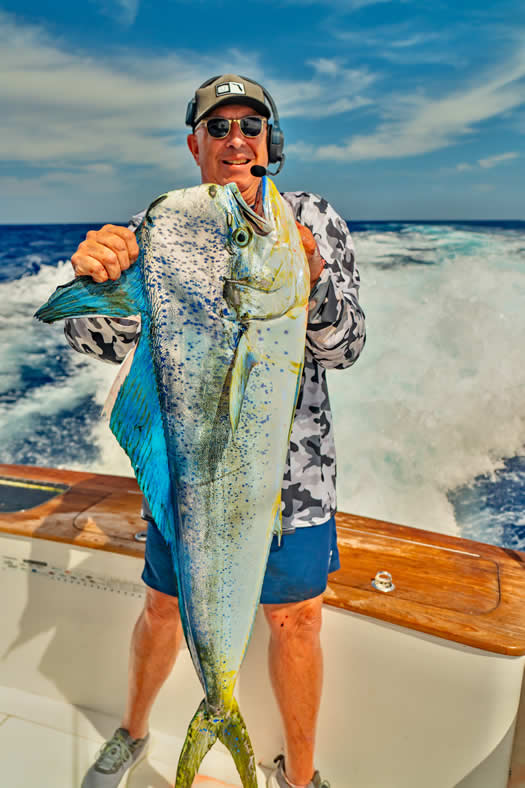
A bull Mahi displaying a less common white and blue pattern.
Conditions
Wind
Mahi are famous for being aggressive feeders, but this is not always the case. Conditions can play a significant factor in finding Mahi and getting them to eat. For instance, in the summertime, we often get winds out of the east off Marathon; this typically means choppy water and great Mahi fishing. Sometimes winds are out of the Southeast, which we also consider pretty good for Mahi, but the waves will be smaller. Winds directly out of the South will mean calmer seas but should still be good enough to catch Mahi as long as there is some wind. A wind out of the West is rare, which is fortunate because the Mahi often seem confused or not hungry at all on those days.
Remember, the wind direction is not the only factor. The speed of the wind matters too! We believe rougher days offer better Mahi fishing. Sometimes tougher conditions near the surface cause the smaller Mahi to push down deeper and open up some big fish opportunities for our Captains.
Distance
How far out the Mahi are can change on any given day, and there are too many factors and variables for us to explain in this article (we will write that article in the future and link to it here). The vital thing to know is the fish are migrating and using currents to travel without burning too much energy and stopping along the way to refuel when they see feeding opportunities. Since they are just passing through and currents and winds shift, just because they were 15 miles offshore yesterday doesn’t mean they will be there today. This is why we require a minimum ¾ day to Offshore fish in the summertime. Every day our Captains need to figure out how far out the Mahi will be that day. Some days it might seem like there are no Mahi at all! Those days mean they are way offshore, too far to travel on a day trip, and when that happens, it is time to try something else and look for other fish.
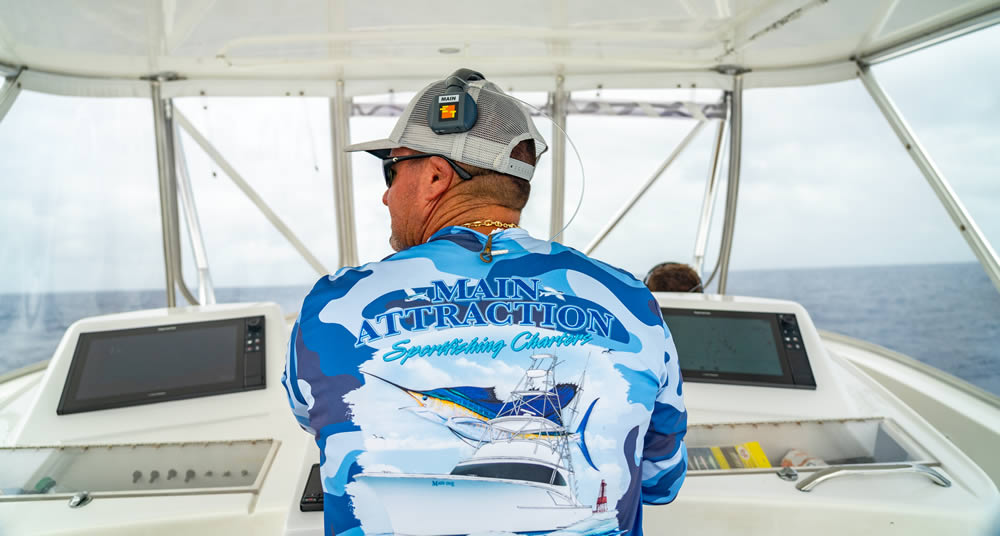
Captain Marty Lewis starts off his Mahi trip on the bridge looking for signs of life on the horizon before heading up to the tower.
Slow Bite
Most clients know our Captains are experienced, well-trained, and fish daily, so they trust them. Sometimes we get anglers that consider themselves very knowledgeable because they fish back home or hire charters for vacation every year. These anglers must understand that fishing the Florida Keys is unlike any other place globally and that our crew members fish hundreds of trips a year and know what they are doing.
This is why we like to share our techniques, so our customers better understand the “methods to our madness.”
By educating yourself to our techniques in advance, If you get on a boat and are not catching fish, you may have a better idea of what is happening. If you find yourself in this situation and begin to doubt the Captain’s decisions, you should immediately talk to the Captain! He will be happy to explain what he is doing and why, and if you want to try something else, you can also ask your Captain what the other options are.
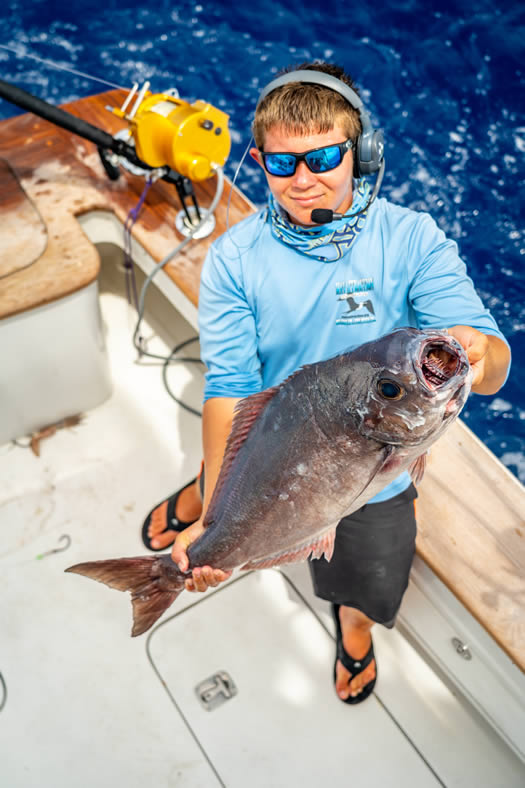
A tasty Barrelfish is a heck of a consolation prize on a tough day of Mahi fishing!
Alternatives to Mahi Fishing
If the Mahi seem nowhere to be found, there are alternatives.
If the conditions are right, your Captain may take you to the Hump where Blackfin Tuna can be found year-round. Sometimes when that happens, they will even find some Mahi hanging around!
If it’s a calm day, the Mahi bite can slow down as well, and our crews are equipped for other types of fishing on those days.
If the current is moving at the right speed, deep-dropping baits for incredible eating fish like Snowy Grouper, Yellow Edge Grouper, Barrelfish, Blackbelly Rosefish, Swordfish, and Tilefish is a wonderful alternative to Mahi fishing in this scenario.
Our vessels are equipped with electric reels for deep dropping on calm days as this is the only time fishing depths well over a thousand feet are viable.
Some of the most delicious fish are found very deep beneath the surface.
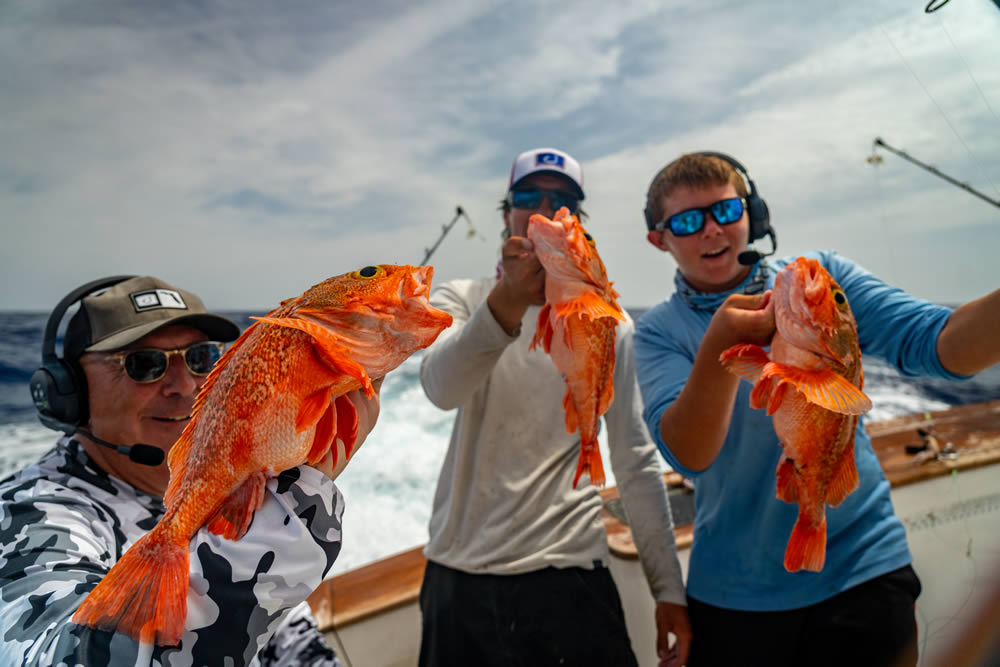
Mark, Lance, and Alex showing off some tasty Blackbelly Rosefish caught while deep dropping.
Best months for Mahi Fishing
2021 Update
We get fishing charter requests from our website every day asking for Mahi no matter what time of year it is! We want to catch your desired fish; however, it is out of our hands if it is not the right time of year for them.
If your heart is set on catching Dolphinfish, you should plan a summertime visit to the Keys. Every year it feels like the Mahi show up a little later. They used to show up as early as March a few years ago. Then early May. Now it seems like they do not start to show until mid-late May, and the fishing doesn’t heat up until June.
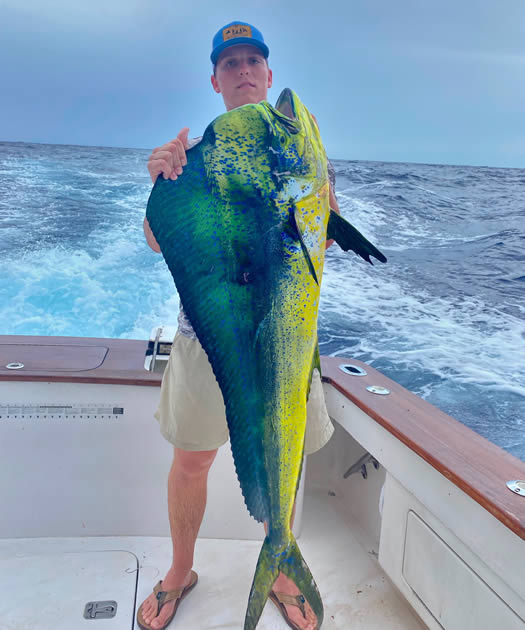
A nice-sized Bull Mahi recently caught aboard the Main One.
Fortunately, the Dolphin fishing generally lasts through August, which is good. Some seasons the Mahi even stick around through September and October.
While the summers are a great time of year for catching Mahi, not every day is Slammer city! Some days it might take all day to get a legal Mahi in the boat. Or some days only lifters and schoolies are available to catch.
As previously mentioned, weather, current, wind direction, even water temperature are all factors that control the Mahi bite. In our opinion, if it’s rough and in season, you have a decent chance of loading the boat with lots of Dolphinfish, but it’s still not guaranteed to happen!
If you look at the last few years for the Marathon Bull and Cow Tournament (held late April/Early May) and the Mother’s Day Dolphin Tournament (held the second weekend in May), you will see smaller fish being weighed in recent years. During the Marathon Bull and Cow, there are typically over 100 boats participating, so yes, someone is bound to find a good fish, but not many are catching very large Dolphinfish early in the year.
This year, a week prior to Memorial Day, we were lucky to catch a few schoolies per boat just because the fish were not here yet. Fast forward a week of wind blowing 20-30 mph, and the Mahi showed up in full force, and the fishing was great. Conditions change daily on the ocean, making what we catch so different from one day to the next.
Last month in June, the Mahi fishing was consistent and pretty good. But, for the first-time angler, the 10-20 mph winds out of the east might not be too enjoyable. As the winds died down, it made things more pleasant for novice anglers, but it also negatively affected the Mahi bite and slowed things down. We are entering July now, and the wind is back, and the Mahi fishing is probably about to heat up again.
Last summer, when we had several weeks of very calm conditions and very little wind, The Mahi fishing was pretty tough. It seemed as if the water was so warm that the Dolphinfish were not coming near the surface like they usually do. What fish we did encounter were lethargic and didn’t want to eat. Once that wind picked up, it helped cool the water temperature down, and sure enough, the fish were biting again. We may not be scientists, and we have no evidence to prove our claims, but after years of fishing nearly every day, these patterns become pretty clear to us.
Communication
As mentioned earlier in this article, Communication is a huge part of having a successful fishing trip. Not only is this important during the fishing trip but also prior to it. If you plan to fish with us please make sure to communicate to us what your expectations and goals are for the trip. If a client is overly exuberant, we will need to temper those expectations. For instance, if it is April and you want to catch Mahi, we will probably tell you that it’s too early for that, or that those specific fish are not here yet and that you will most likely be targeting something else such as Sailfish. If a client expects to catch Mahi, Dolphin, Marlin, and Sailfish on the same day, we will also explain to them that it will not happen, and that is not how fishing works. Because fishing is a sport with many variables, our customers can not order the fish they want in advance as if it is a restaurant or a fish market! We need to go out there to see what we can find, present it with the right bait, see if it eats, and then see if we can catch it.
Attitude
Having a great attitude is one of the single best ways to ensure a successful trip. Coming into a trip with high expectations or in a demanding manner is setting yourself up for failure. The point of hiring a charter to go fishing while you are on vacation is to have fun! If you were only looking for meat, you would go to the market. Hiring a charter is about the experience and the adventure. If you show up and say you want to catch Mahi, and your Captain says the Mahi aren’t here yet, but the Tuna fishing will probably be good today, you should do the wise thing and go Tuna fishing. Demanding to catch a species that is not in season or not recommended by management or your Captain will most likely have poor results.
In Closing
We hope you found this article interesting and helpful. Mahi fishing is an enjoyable and exciting activity with a wonderful reward of fresh fillets at the end of most days. It is the perfect way to add some fun and excitement to your Florida Keys Vacation. We hope you do it sometime soon as it can make for some very memorable moments.
Mahi fishing is also a great team-building exercise for Families, Friends, and Co-workers when there is a big school of fish behind the boat. If you expect everyone in your party to be holding a fishing rod at the same time, Mahi fishing is your best chance of that actually happening, as most types of fishing in the Keys do not work that way.
So What’s the Secret?
The secret to successful Mahi fishing charters in the Florida keys is all throughout this article, but it primarily comes down to being prepared, communication, teamwork, and being flexible in your approach if the conditions dictate that Mahi fishing isn’t going to be easy that day. It also doesn’t hurt to have an experienced crew like the Main Attraction team to help you achieve your Mahi fishing goals! If you are interested in booking a fishing trip with the Main Attraction, please call us at (305)-289-0071 or visit our contact page.
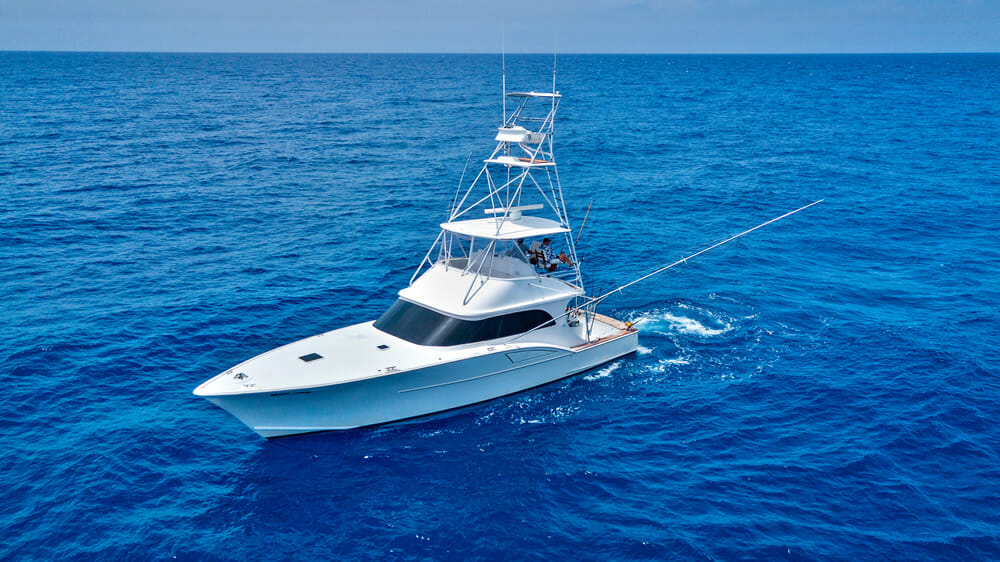
Our 49′ Sportfishing vessel the Main One.
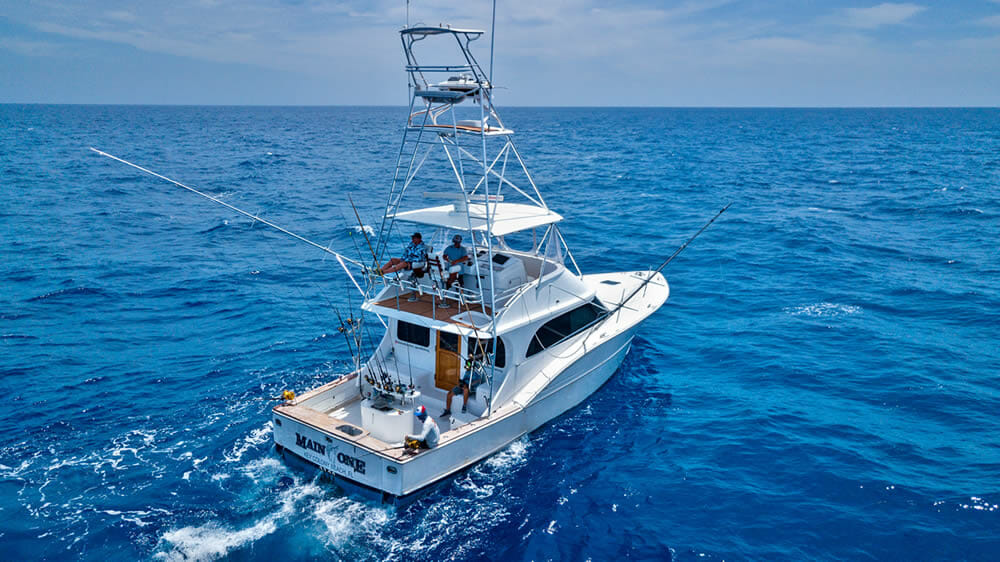
The Main One is Mahi catching machine!




